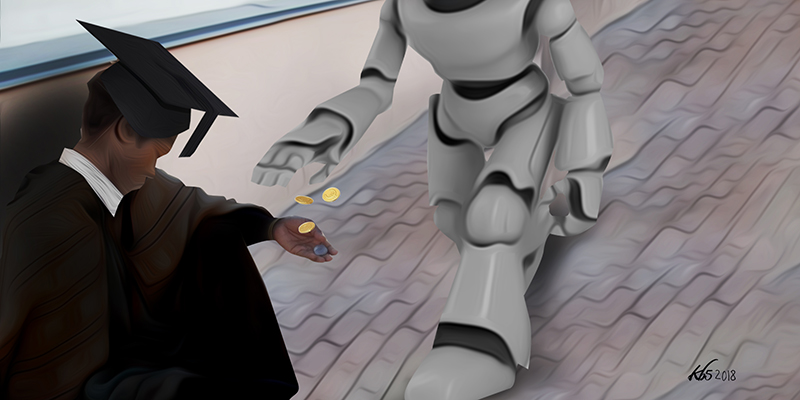In my last feature, I wrote on the six capacity challenges facing African universities: institutional supply, resources, faculty, research, outputs, and leadership. In this essay, I focus on one critical aspect of the outputs of our universities, namely, the employability of our graduates. To be sure, universities do not exist simply for economic reasons, for return on investment, or as vocational enterprises. They also serve as powerful centers for contemplation and the generation of new knowledges, for the cultivation of enlightened citizenship, as crucibles for forging inclusive, integrated, and innovative societies, and as purveyors, at their best, of cultures of civility, ethical values, and shared well-being.
Nevertheless, the fact remains that higher education is prized for its capacity to provide its beneficiaries jobs and professional careers. Thus, employability is at the heart of the value proposition of university education; it is its most compelling promise and unforgiving performance indicator. The evidence across Africa, indeed in many parts of the world, is quite troubling as mismatches persist, and in some cases appear to be growing, between the quality of graduates and the needs of the economy. This often results in graduate underemployment and unemployment.
The Employability Challenge
There are two powerful mega trends that will determine Africa’s development trajectory in the 21st century. The first is the continent’s youth bulge, and the second the changing nature of work. Employability is the nexus between the two, the thread that will weave or unravel the fabric of the continent’s future, enabling it to achieve or abort the enduring historic and humanistic project for development, democracy, and self-determination.
As we all know, Africa’s youth population is exploding. This promises to propel the continent either towards a demographic dividend of hosting the world’s largest and most dynamic labor force or the demographic disaster of rampant insecurity and instability fueled by hordes of ill-educated and unemployable youths. According to United Nations data, in 2017 the continent had 16.64% (1.26 billion) of the world’s population, which is slated to rise, on current trends, to 19.93% (1.70 billion) in 2030, and 25.87% (2.53 billion) in 2050, and 39.95% (4.47 billion) in 2100.
The African Development Bank succinctly captures the challenge and opportunity facing the continent: “Youth are Africa’s greatest asset, but this asset remains untapped due to high unemployment. Africa’s youth population is rapidly growing and expected to double to over 850 million by 2050. The potential benefits of Africa’s youth population are unrealized as two-thirds of non-student youth are unemployed, discouraged, or only vulnerably employed despite gains in education access over the past several decades.”
Thus, the youth bulge will turn out to be a blessing or curse depending on the employability skills imparted to them by our educational institutions including universities. Across Africa in 2017 children under the age of 15 accounted for 41% of the population and those 15 to 24 for another 19%. While African economies have been growing, the rate of growth is not fast enough to absorb the masses of young people seeking gainful employment. Since 2000 the rate of employment has been growing at an average rate of 3%. Africa needs to double this rate or more to significantly reduce poverty and raise general standards of living for its working people.
Not surprisingly, despite some improvements over the past two decades, the employment indicators for Africa continue to be comparatively unsatisfactory. For example, International Labor Organization data shows that in 2017 the unemployment rate in Africa was 7.9% compared to a world average of 5.6%; the vulnerable employment rate was 66.0% to 42.5%; the extreme working poverty rate was 31.9% to 11.2%; and the moderate working poverty rate was 23.6% to 16.0%, respectively.
This data underscores the fact that much of the growth in employment in many African countries is in the informal sector where incomes tend to be low and working conditions poor. In sectoral terms, there appears to be a structural decline in agricultural and manufacturing employment, and rise in service sector jobs. Yet, in many African countries both the declining and rising sectors are characterised by high incidence of vulnerable, informal, and part-time jobs.
The structural shifts in employment dynamics across much of Africa differ considerably from the historical path traversed by the developed countries. But the latter, too, are experiencing challenges of their own as the so-called fourth industrial revolution unleashes its massive and unpredictable transformations. In fact, the issue of graduate employability, as discussed in the next section is not a monopoly of universities in Africa and other parts of the Global South. It is also exercising the minds of educators, governments, and employers in the Global North.
The reason is simple: the world economy is undergoing major structural changes, which are evident everywhere even if their manifestations and intensity vary across regions and countries. As deeply integrated as Africa is in the globalized world economy, it means the continent’s economies are facing double jeopardy. They are simultaneously confronting and navigating both the asymmetrical legacies of the previous revolutions and the unfolding revolution of digital automation, artificial intelligence, the internet of things, biotechnology, nanotechnology, robotics, and so on in which the old boundaries of work, production, social life, and even the meaning of being human are rapidly eroding.
The analysis above should make it clear that employability cannot be reduced to employment. Employability entails the acquisition of knowledge, skills, and attributes, in short, capabilities to pursue a productive and meaningful life. To quote an influential report by the British Council, “Employability requires technical skills, job-specific and generic cognitive attributes, but also a range of other qualities including communication, empathy, intercultural awareness and so forth…. Such a perspective guards against a reductive ‘skills gap’ diagnosis of the problems of graduate unemployment.” The challenge for universities, then, is the extent to which they are providing an education that is holistic, one that provides subject and technical knowledges, experiential learning opportunities, liberal arts competencies, and soft and lifelong learning skills.
As deeply integrated as Africa is in the globalized world economy, it means the continent’s economies are facing double jeopardy. They are simultaneously confronting and navigating both the asymmetrical legacies of the previous revolutions and the unfolding revolution of digital automation, artificial intelligence, the internet of things, biotechnology, nanotechnology, robotics, and so on in which the old boundaries of work, production, social life, and even the meaning of being human are rapidly eroding.
But in addition to the attributes, values, and social networks acquired and developed by an individual in a university, employability depends on the wider socio-economic and political context. Employability thrives in societies committed to the pursuit of inclusive development. This entails, to quote the report again, “a fair distribution of the benefits of development (economic and otherwise) across the population, and allows equitable access to valued opportunities. Second, while upholding equality of all before the law and in terms of social welfare, it also recognizes and values social diversity. Third, it engages individuals and communities in the task of deciding the shape that society will take, through the democratic participation of all segments of society.”
In short, employability refers to the provision and acquisition, in the words of an employability study undertaken at my university, USIU-Africa in 2017, “of skills necessary to undertake self-employment opportunities, creation of innovative opportunities as well as acquiring and maintaining salaried employment. It is the capacity to function successfully in a role and be able to move between occupations…. employability skills can be gained in and out of the classroom and depend also on the quality of education gained by the individuals before entry into the university. As such the role of the university is to provide a conducive environment and undertake deliberate measures to ensure that students acquire these skills within their period of study.”
Universities and Employability
The African media is full of stories about the skills mismatch between the quality of graduates and the needs of employers and the economy. Many graduates end up “tarmacking” for years unemployed or underemployed. In the meantime, employers complain bitterly, to quote a story in University World News “unprepared graduates are raising our costs.” The story paints a gloomy picture: “The Federation of Kenya Employers (FKE) – a lobby group for all major corporate organizations – says in its latest survey that at least 70% of entry-level recruits require a refresher course in order to start to deliver in their new jobs. As a result, they take longer than expected to become productive, nearly doubling staff costs in a majority of organizations.”
[E]mployability cannot be reduced to employment. Employability entails the acquisition of knowledge, skills, and attributes, in short, capabilities to pursue a productive and meaningful life
The situation is no better in the rest of the region. The story continues, noting that a study of the Inter-University Council for East Africa, “shows that Uganda has the worst record, with at least 63% of graduates found to lack job market skills. It is followed closely by Tanzania, where 61% of graduates were ill prepared. In Burundi and Rwanda, 55% and 52% of graduates respectively were perceived to not be competent. In Kenya, 51% of graduates were believed to be unfit for jobs.” The situation in Kenya and East Africa clearly applies elsewhere across Africa.
But the problem of employability afflicts universities and economies in the developed countries as well. Studies from the USA and UK are quite instructive. One is a 2014 Gallup survey of business leaders in the United States. To the statement “higher education institutions in this country are graduating students with the skills and competencies that my business needs,” only 11% strongly agreed and another 22% agreed, while 17% strongly disagreed and another 17% disagreed, and the rest were in the middle. In contrast, in another Gallup survey, also conducted in 2014, 96% of the provosts interviewed believed they were preparing their students for success in the workforce. Another survey by the Association of American Colleges and Universities highlighted the discrepancy between students’ and employers’ views on graduates preparedness. “For example, while 59 percent of students said they were well prepared to analyze and solve complex problems, just 24 percent of employers said they had found that to be true of recent college graduates.”
In Britain, research commissioned by the Edge Foundation in 2011 underscored the same discrepancies. The project encompassed 26 higher education institutions and 9 employers. The report concluded, “While there are numerous examples of employers and HEIs working to promote graduate employability in the literature and in our research, there are still issues and barriers between employers and many of those responsible for HEI policy, particularly in terms of differences in mindset, expectations and priorities. There are concerns from some academics about employability measures in their universities diminishing the academic integrity of higher education provision. There is also frustration from employers about courses not meeting their needs.”
Specifically, the reported noted, “Employers expect graduates to have the technical and discipline competences from their degrees but require graduates to demonstrate a range of broader skills and attributes that include team-working, communication, leadership, critical thinking, problem solving and often managerial abilities or potential.” One could argue, this is indeed a widespread expectation among employers whether in the developed or developing countries.
Predictably, in a world that is increasingly addicted to rankings as a tool of market differentiation and competition, national and international employability rankings have emerged. One of the best known is the one by Times Higher Education, whose 2017 edition lists 150 universities from 33 countries. As with the general global rankings of universities, the rankings are dominated by American institutions, with 7 in the top 10 and 35 overall, followed by British universities with 3 in the top 20 and 9 overall. Africa has only one university in the league, the University of the Witwatersrand listed in last place at 150.
What, then, are some of the most effective interventions to enhance the employability of university graduates? There is no shortage of studies and suggestions. Clearly, it is critical to embed employability across the institution from the strategic plan, to curriculum design, to the provision of support services such as internships and career counseling. The importance of carefully crafted student placements and experiential and work-related learning cannot be overemphasized. We can all borrow from each other’s best practices duly adapted to fit our specific institutional and local contexts.
Cooperative education that combines classroom study and practical work has long been touted for its capacity to impart employability skills and prepare young people transition from higher education to employment. Work-integrated learning and experiential learning encompass various features and practices including internships, placements, and service learning. In the United States and Canada several universities adopted cooperative education and work-integrated learning in the first decades of the 20th century. The movement has since spread to many parts of the world. The World Council of Cooperative Education, which was founded in 1983, currently has 913 institutions in 52 countries.
What, then, are some of the most effective interventions to enhance the employability of university graduates?… Clearly, it is critical to embed employability across the institution from the strategic plan, to curriculum design, to the provision of support services such as internships and career counseling. The importance of carefully crafted student placements and experiential and work-related learning cannot be overemphasized. We can all borrow from each other’s best practices duly adapted to fit our specific institutional and local contexts.
The Developing Employability Initiative (DEI), a collaboration comprising 30 higher education institutions and over 700 scholars internationally, defines employability as “the ability to create and sustain meaningful work across the career lifespan. This is a developmental process which students need to learn before they graduate.” It urges higher education institutions to embed employability thinking in their teaching and learning by incorporating what is termed basic literacy, rhetorical literacy, personal and critical literacy, emotional literacy, occupational literacy, and ethical, social and cultural literacy.
The DEI has developed a suggestive framework of what it calls essential employability qualities (EEQ). These qualities, “are not specific to any discipline, field, or industry, but are applicable to most work-based, professional environments; they represent the knowledge, skills, abilities, and experiences that help ensure that graduates are not only ready for their first or next job, but also support learners’ foundation for a lifetime of engaged employment and participation in the rapidly changing workplace of the 21st century.” Graduates with EEQ profile are expected to be communicators, thinkers and problem solvers, inquirers and researchers, collaborators, adaptable, principled and ethical, responsible and professional, and continuous learners.
Equipping students with employability skills and capacities is a continuous process in the context of rapidly changing occupational landscapes. I referred earlier to the disruptions caused by the fourth industrial revolution which will only accelerate as the 21st century unfolds. Automation will lead to the disappearance of many occupations—think of the transport industry with the spread of driverless cars, sales jobs with cashless shops, or medical careers with the spread of machine and digital diagnoses. But new occupations will also emerge, many of which we can’t even predict, a prospect that makes the skills of liberal arts education and lifelong learning even more crucial.
We should not be preparing students for this brave new world in the same manner as many of us were educated for the world of the late 20th century. To quote Robert Aoun, President of Northeastern University in the USA that is renowned for its cooperative education, let us provide robot-proof higher education, one that “is not concerned solely with topping up students’ minds with high-octane facts. Rather, it calibrates them with a creative mindset and the mental elasticity to invent, discover, or create something valuable to society.” The new literacies of the new education include data literacy, technological literacy, and human literacy encompassing the humanities, communication and design.
Achieving the ambitious agenda of equipping university students with employability skills, attributes, experiences, and mindsets for the present and future requires the development of effective and mutually beneficial, multifaceted and sustained engagements and partnerships between universities, employers, governments and civil society. Within the universities themselves there is need for institutional commitment at all levels and a compact of accountability between administrators, faculty, and students.
This entails developing robust systems of learning assessment including verification of employability skills, utilization of external information and reviews, integration of career services, and cultivating strong cultures of student, alumni and employer engagement, representation and partnerships in assuring program relevance and quality. Pursuing these goals is fraught with challenges, in terms of striking a balance between the cherished traditions of institutional autonomy and academy freedom, in engaging employers without importing the insidious cultures of what I call the 5Cs of the neo-liberal academy: corporatization of management, consumerization of students, casualization of faculty, commercialization of learning, and commodification of knowledge.
The challenges of developing and fostering employability skills among students in our universities are real and daunting. But as educators we have no choice but to continue striving, with the full support and engagement of governments, intergovernmental agencies, the private sector, non-governmental organisations, and civil society organisations, to provide the best experiential and work integrated learning we can without compromising the enduring and cherished traditions and values of higher education. The consequences of inaction or complacency, of conducting business as usual are too ghastly to contemplate: it is to condemn the hundreds of millions of contemporary African youth and the youths yet to be born to unemployable and unlivable lives. That would be an economic, ethical, and existential tragedy of monumental proportions for which history would never forgive us.
This is an abridged version of a keynote address delivered at Malawi’s First International Conference on Higher Education, June 27, 2018.








